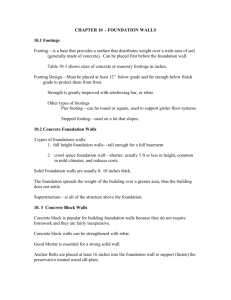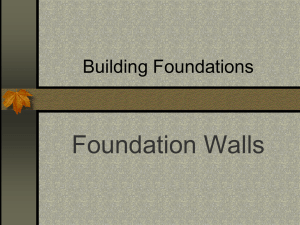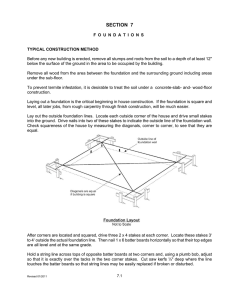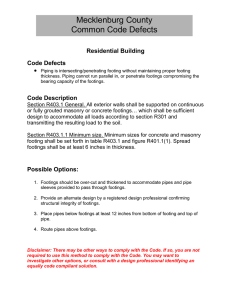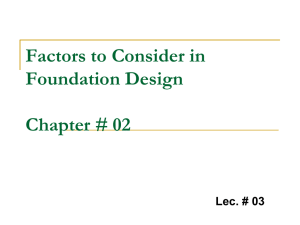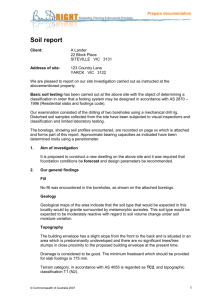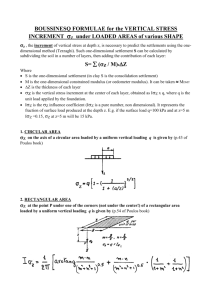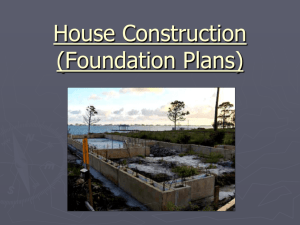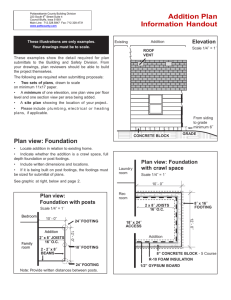Staking out a house location –
advertisement
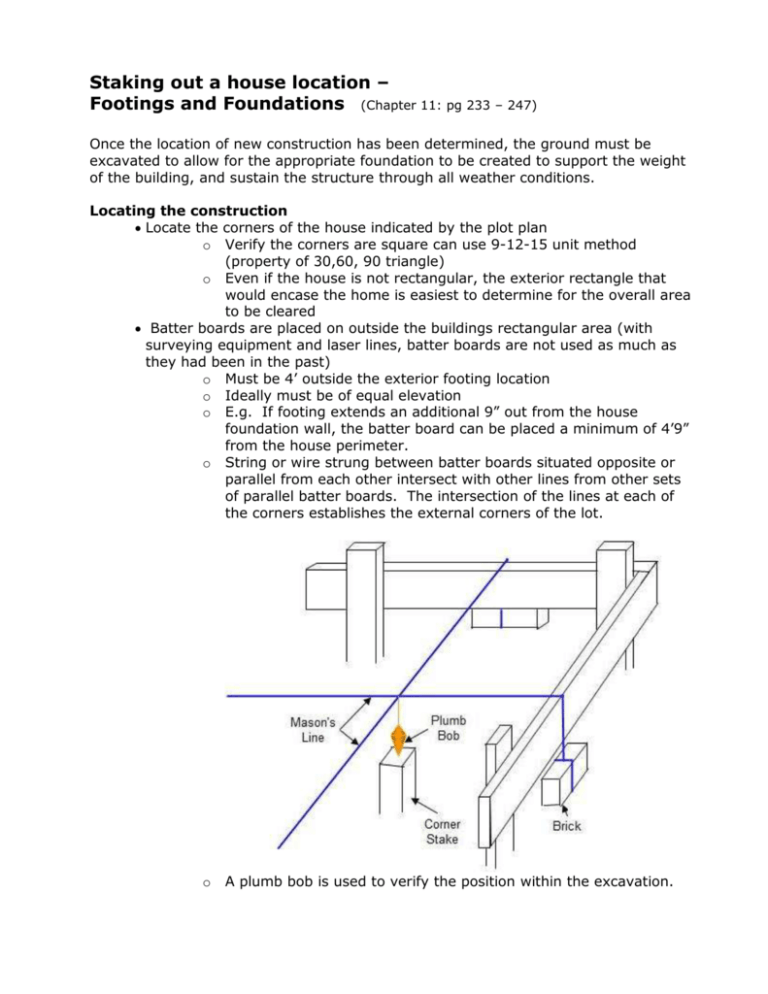
Staking out a house location – Footings and Foundations (Chapter 11: pg 233 – 247) Once the location of new construction has been determined, the ground must be excavated to allow for the appropriate foundation to be created to support the weight of the building, and sustain the structure through all weather conditions. Locating the construction Locate the corners of the house indicated by the plot plan o Verify the corners are square can use 9-12-15 unit method (property of 30,60, 90 triangle) o Even if the house is not rectangular, the exterior rectangle that would encase the home is easiest to determine for the overall area to be cleared Batter boards are placed on outside the buildings rectangular area (with surveying equipment and laser lines, batter boards are not used as much as they had been in the past) o Must be 4’ outside the exterior footing location o Ideally must be of equal elevation o E.g. If footing extends an additional 9” out from the house foundation wall, the batter board can be placed a minimum of 4’9” from the house perimeter. o String or wire strung between batter boards situated opposite or parallel from each other intersect with other lines from other sets of parallel batter boards. The intersection of the lines at each of the corners establishes the external corners of the lot. o A plumb bob is used to verify the position within the excavation. The Excavation Once the size and location of the excavation is determined the excavation can take place. Depth is dependent on frost penetration depth (should be 6” to 1’ below this depth), depth of the basement (ceiling height) and keeping that the first floor should be a minimum of 8” above grade (ground level). Point of reference for the depth is from the highest corner of the structure. frost line penetration in Ottawa is 42” The Footing – is an enlarged base of the foundation wall that must be massive enough to distribute the weight of the building to the ground below. It is not required if a construction is built on rock. The size depends on the soil conditions The depth depends on the frost penetration depth in the area Ideally should be place on undisturbed soil. Poured concrete is the most widely used material o Footing is formed (often by using wood forms) to create the exterior edge of the footing Key or keyway (a groove that is formed prior to setting) can be place in footing to help keep the wall from sliding side to side o Generally, are 1/2 the wall thickness at the top and 1/3 the wall thickness deep, with sloping sides and is centered on the footing. o Alternately, rebar can be placed so it sticks up from the center of the footing so the next level can be kept in place. General rule for light construction (basic housing) footings are typically twice the width of the foundation wall and as high as the width of the wall. Rebar can be added to concrete to reinforce the footing Footings for chimneys and fireplaces must support greater weight and thus are larger (12” thick and extend 6” beyond the perimeter of the chimney on all sides) Stepped footings used on hilly terrain, o Each step must be completely horizontal o Needs rebar reinforcement on vertical and horizontal where step is located o Height of each step should not exceed 2’ Column or Post Footings Used to support concentrated loads in the building (i.e. floor joists) Typically for small residences is 24” square by 12” deep o Can hold 16,000 lbs if soil were dry firm sand or clay (see table below) Soil Load – Bearing Qualities Type of Soil Soft clay, loam Dry, firm sand or clay Compact coarse sand Coarse gravel Hard pan or shale Solid rock Safe Load Tons per sq ft. lb per sq ft 1 2 3 4 10 No limit 2000 4000 6000 8000 20000 Types of Foundation walls: 4 basic types T-foundation, slab foundation, pier or post foundation, wood foundation T-foundations – name derived from inverted T shape o Foundation and footing are two separate parts o Forms for the footings are made from 2” thick construction lumber – after concrete is set the forms are removed Slab foundations – an extension of the slab floor o Placed at same time as the floor is cast (not separate) o Steel mesh and/ or reinforcing bars are recommended to prevent cracking during settling o Requires less time , expense and labour to construct o May be used for a storage or deck type structures, no longer legal locally for main house o Not really for areas which require a basement Pier and Post foundations o As described with column or post footings, used for short spans for additional support Wood foundations – only attractive in climate where freezing is infrequent Foundation walls Generally built of poured concrete or concrete block Poured concrete o is labour intensive to create form walls o time consuming to allow for concrete to set and harden o resists fractures from settling and o allows for stele reinforcement at critical points o not restricted to block dimensions o usually 8” thick o limit height of structure to 10x their thickness for unreinforced walls generally foundation should be as thick as masonry above o brick or stone veneer 8” thick foundation is sufficient for 1 storey 10” thick foundation for 2 storey o Moisture conditions in the soil may require thicker walls to ensure dryness in basement (with exterior waterproofing and proper drainage) Concrete block o Allows for economy in speed of erection and cost o Design and workmanship can be a factor in effectiveness o Capped with 4” solid cap block Provides smooth bearing surface for wood sills etc. o Cores need to be filled where beams, girders and heavy loads are expected. o Mortar joints are the weakest part of the wall. o Design should not require blocks to be cut should be multiples of 8” or 16” Pilasters o a rectangular column that project from a wall for additional support for girders or beams (not used often) o built at same time as basement wall o min width 16” must project 4” inside a 8” foundation wall Exterior of walls: o Parge coat of plaster or cement mortar are used damp proof foundation wall o Other materials like tar, rubber membranes and insulation are used to further weather proof and insulate the walls Draining o 4” perforated drain tile (weeping tile) is placed around the perimeter of the footing to move ground water away from the base of the structure o Tile is covered with approximately 18”course stone or gravel o In wet areas for additional protection sump pumps are installed to pump water away from the base of the structure Homework: 1. Draw on CADD the cross section for a T-foundation with: a) 10” wide poured foundation wall 6’ height and a key (keyway) b) Block foundation wall 10 blocks high and poured footing, also with a key. Add a pilaster to hold a 2”x10” wood floor joist (need two views) Include the external weeping tile, fill and soil to grade 2. Do the review questions from Chapter 11 #1-11 Image resources: http://www.using-concrete.com/foundation-4.htm http://www.nrccnrc.gc.ca/eng/ibp/irc/rr/rr199/part4.html http://www.renovationheadquarters.com/footings.html http://www.condor-rebar.com/newsarticles/2011-03-sloped-vs-stepped-footings.html
